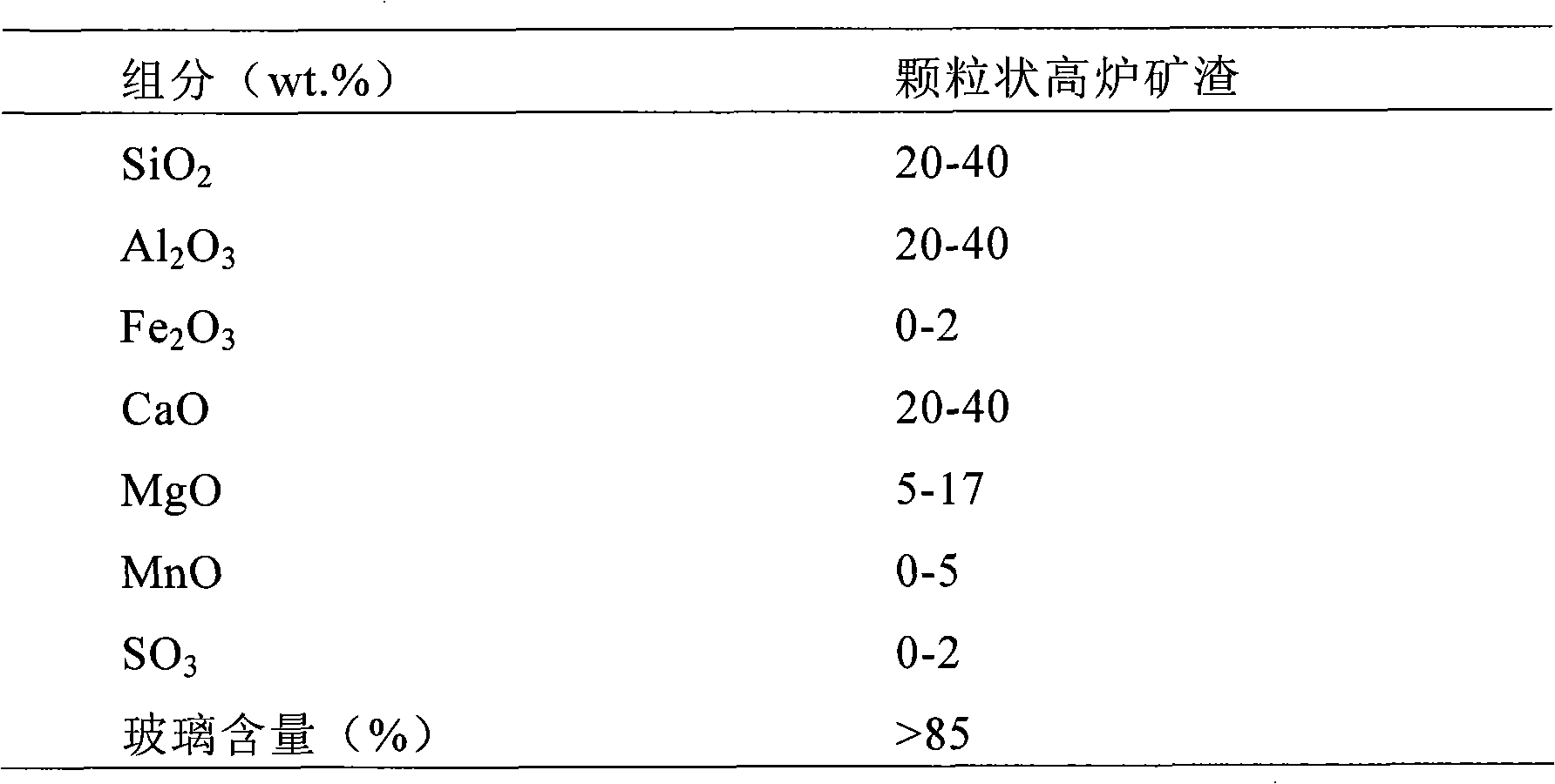A process for the production of reactive blast furnace slag
A technology of blast furnace slag and activity, which is applied in the field of preparation of active granular blast furnace slag to achieve the effect of enhancing activity and improving activity
- Summary
- Abstract
- Description
- Claims
- Application Information
AI Technical Summary
Problems solved by technology
Method used
Image
Examples
Embodiment 1
[0051] 1kg of blast furnace slag is dry ground in a ball mill for 45 minutes. The particle size obtained after ball milling is 100 microns. 150g of ball-milled blast furnace slag was used as the feed, and water was used as a medium to wet-grind in a grinder for 10 minutes. The feed to water ratio is 1:1.5, and the feed to ball ratio is 1:10. The size of the ball is 2 mm, and the stirring rate is 1000 rpm. The slag obtained after the grinder treatment is evaluated according to its median particle size, shape, Zeta voltage, stable suspension volume (the volume occupied by 100g slag when there is excess water), and the start time of hydration. Determine the start time of hydration by standard isothermal conductance calorimetry. A slag slurry equivalent to 100 g of slag was taken from the grinder and hydrated at room temperature for 28 days. A 28-day uniform hydrated slag sample was used to measure the activity of the slag, and the activity was expressed as the thermogravimetric loss ...
Embodiment 2
[0055] 1kg of blast furnace slag was dry ground in a ball mill for 45 minutes. The particle size obtained after ball milling is 100 microns. 150g of ball-milled blast furnace slag is used as the feed, and water is used as a medium to wet-grind in a grinder for 15 minutes. The feed to water ratio is 1:1.5, and the feed to ball ratio is 1:10. The size of the ball is 2 mm, and the stirring rate is 1000 rpm. The slag obtained after the grinder treatment is evaluated according to its median particle size, shape, Zeta voltage, stable suspension volume (the volume occupied by 100g slag when there is excess water), and the start time of hydration. Use standard isothermal conductance calorimetry to determine the start time of hydration. The water was separated from the slurry obtained after the attritor treatment by filtration, and the material was dried in an electric furnace at 40°C for 6 hours, and then cooled to room temperature. 100 g of dry slag was mixed with excess water to be comp...
Embodiment 3
[0059] 1kg of blast furnace slag is dry ground in a ball mill for 45 minutes. The particle size obtained after ball milling is 100 microns. 150g of ball-milled blast furnace slag was used as the feed, and water was used as a medium to wet-grind in a grinder for 30 minutes. The feed to water ratio is 1:1.5, and the feed to ball ratio is 1:10. The size of the ball is 2 mm, and the stirring rate is 1000 rpm. The slag obtained after the grinder treatment is evaluated according to its median particle size, shape, Zeta voltage, stable suspension volume (the volume occupied by 100g slag when there is excess water), and the start time of hydration. Determine the start time of hydration by standard isothermal conductance calorimetry. A slag slurry equivalent to 100 g of slag was taken from the grinder and hydrated at room temperature for 28 days. A 28-day symmetrical hydrated slag sample was used to measure the activity of the slag, and the activity was expressed as the thermogravimetric l...
PUM
| Property | Measurement | Unit |
|---|---|---|
| size | aaaaa | aaaaa |
Abstract
Description
Claims
Application Information
 Login to View More
Login to View More - R&D
- Intellectual Property
- Life Sciences
- Materials
- Tech Scout
- Unparalleled Data Quality
- Higher Quality Content
- 60% Fewer Hallucinations
Browse by: Latest US Patents, China's latest patents, Technical Efficacy Thesaurus, Application Domain, Technology Topic, Popular Technical Reports.
© 2025 PatSnap. All rights reserved.Legal|Privacy policy|Modern Slavery Act Transparency Statement|Sitemap|About US| Contact US: help@patsnap.com

